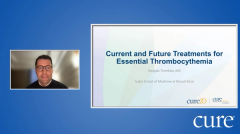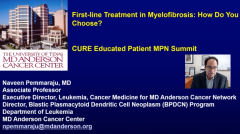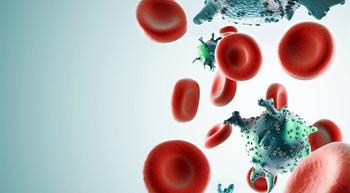
Educated Patient® MPN Summit Defining Essential Thrombocythemia Risk Presentation: November 19, 2022
Watch Dr. Aaron T. Gerds, from Cleveland Clinic Taussig Cancer Institute, discuss essential thrombocythemia risk during the CURE Educated Patient MPN Summit.
Episodes in this series

Understanding the different types of risks faced by people with essential thrombocythemia, a type of cancer associated with uncontrolled growth of blood platelets, is crucial to helping patients live “effectively normal life spans,” according to an expert
Dr. Aaron T. Gerds, the deputy director for Clinical Research at Cleveland Clinic Taussig Cancer Institute, discussed how monitoring for mutations in the bone marrow can help doctors find who is at an increased risk for essential thrombocythemia and the different models that can be used to understand the disease further at CURE®’s Educated Patient® MPN Summit.
Understanding Essential Thrombocythemia
Essential thrombocythemia, Gerds explained in an interview with CURE®, is a disease caused by too many platelets in a patient’s bloodstream. Of note, blood platelets are small pieces of cells that help form blood clots to slow or stop bleeding and to help wounds heal.
Unlike reactive thrombocythemia which is when something else in the body is driving the production of these excess blood platelets, he said, essential thrombocythemia occurs when the bone marrow acquires a mutation that causes uncontrolled growth of platelets-creating cells.
Gerds emphasized that although essential thrombocythemia is a type of blood cancer, it is not the same as acute leukemia, an aggressive form of blood cancer that can have a very low survival rate if left untreated. Instead, essential thrombocythemia should be considered as a type of chronic leukemia and that, with careful monitoring for risk factors, “people (with essential thrombocythemia) can live effectively normal lifespans,” even without a cure, he noted.
Staging Versus Prognostic Models
Other cancers, Gerds explained, use a staging system based on geography and how far the cancer has traveled from the tissue of origin. For example, breast cancer is considered stage 1 or 2 if it hasn’t spread outside the breast or surrounding lymph nodes but is stage 3 or 4 if it has started spreading. This is useful for measuring the severity of the illness: stage 1 will have a better prognosis than stage 4.
However, according to Gerds, this model doesn’t work with leukemias because blood is located throughout the body. As a result, a different model is needed for patients to understand their illnesses.
“Prognostic models (are) kind of like our staging system,” he explained. “We take clinical factors, assign them points and come up with a score.”
That score is used to assign low, middle or high risk to a disease. The most common scoring system used by doctors is the IPSET-t score, which is used to calculate survival for patients with essential thrombocythemia.
Evolution of Prognostic Models
According to Gerds, the original models used only included age, white blood cell count and history of thrombosis, which is when blood clots block veins or arteries. Newer models have been updated to include age, sex, white count and adverse mutations in specific genes.
Patients with essential thrombocythemia are at an increased risk for blood clots but doctors are not sure why, he continued. Research has indicated that people with mutations in the JAK2 gene, which provides instructions to the cell for making a protein that promotes the growth and division of cells, are more likely to have blood clots. As a result, JAK2 mutations are looked at closely in prognostic models analyzing risk for patients with essential thrombocythemia.
Gerds highlighted the importance of adding mutation analysis to these models, explaining that a person with adverse mutations would have been considered low risk in the original model but could be considered high risk in the updated model.
“The power of this mutation analysis (is that) it can find disease that's more likely to progress to myelofibrosis or acute leukemia in the future and refine how we think about overall prognosis,” he said.
Making Models Useful for Patients
Gerds stressed that patients with essential thrombocythemia who want to review their own risk models should keep in mind that there are two sets of prognostic models doctors use: one to predict survival and a thrombosis model to monitor blood clots. Patients, for example, may be at low risk for survival but high risk for blood clots. While the survival model calculates how many years the patients will survive, the thrombosis model drives treatment plans. He recommended seeking the counsel of their doctors when reviewing these models to avoid confusion.
Knowing their risk can be very helpful for patients with essential thrombocythemia, Gerds explained. For patients who are at lower risk, doctors will know to monitor their symptoms very closely to ensure that their disease does not turn into acute leukemia. While there is currently no intervention for patients with high-risk mutations, having an idea of their survival rate can help patients make practical decisions about their life and make informed medical decisions.
Gerds hopes that more can be done for high-risk patients with essential thrombocythemia in the future.
“The next step in evolution (of prognostic models) is that once we identify people who are higher risk, (we can) apply a therapy that reduces or modifies that risk,” he concluded.
For more news on cancer updates, research and education, don’t forget to













